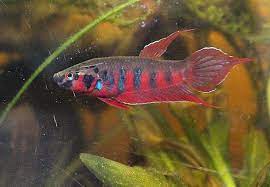Betta Rubra

Credit: Jessie Lynn Billington
Betta rubra, also known as the Toba Betta, is a stunning wild betta species native to Lake Toba in Indonesia. Their compact size, subtle yet vibrant coloration, and engaging behaviors make them a fascinating choice for experienced aquarists seeking something unique.
Understanding the Needs of Betta Rubra
Click here for my favorite betta fish care guide for a happy & healthy life…
- Habitat Replication: Betta rubra comes from slow-moving blackwater environments. Providing soft, acidic water is critical. Consider the following:
- pH: 5.0-6.5
- Hardness: Very soft (GH 0-5, KH 0-3)
- Temperature: 77-82°F (25-28°C)
- Tank Setup: Start with a minimum of 5 gallons, but larger is better for this active fish. Densely plant your tank with live or high-quality silk plants. Include driftwood, Indian almond leaves, and subdued lighting to mimic their natural habitat. Opt for a gentle filtration system like a sponge filter.
- Peaceful Nature: Betta rubra is relatively peaceful compared to some betta species, opening up possibilities for tank setups beyond a single fish.
Feeding Your Betta Rubra
Wild Betta rubra are predominantly insectivores. Provide a varied diet for optimal health:
- Live Foods: Favorites include daphnia, bloodworms, and mosquito larvae.
- Frozen Foods: Substitute for live food when necessary.
- Pellets: Choose high-quality betta pellets formulated with minimal fillers as an occasional supplement.
Temperament and Tank Mates
- Males: They are best kept singly unless you have a large, very densely planted tank. Males can exhibit territoriality toward each other.
- Females: Can sometimes cohabitate in a spacious tank with ample hiding spots. Close supervision is a must, even with females.
- Community Tanks: Betta Rubra might suit a carefully designed community setup. Potential tank mates include small, peaceful species that thrive in similar water conditions, such as certain rasboras or tetras. Avoid large or boisterous tankmates.
Breeding Betta Rubra
Breeding Betta rubra requires dedication and experience. Here’s an overview:
- Separate Breeding Tank: Set up a dedicated breeding tank with soft, acidic water and plenty of cover.
- Conditioning the Pair: Feed the male and female high-quality live foods for several weeks before breeding.
- Courtship and Spawning: Betta rubra are bubble nesters. Observe their elaborate courtship dances and bubble nest building.
- Fry Care: Fry are tiny and require specialized foods (infusoria, microworms).


